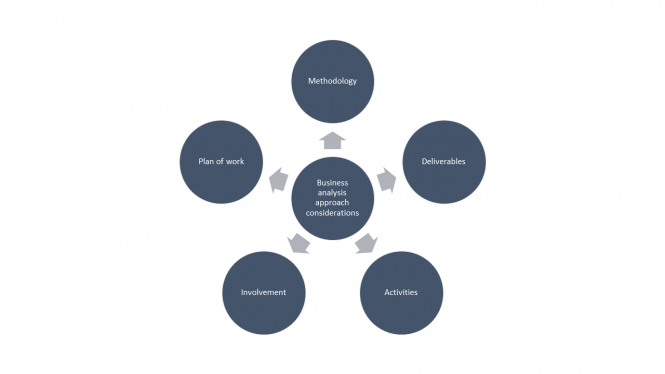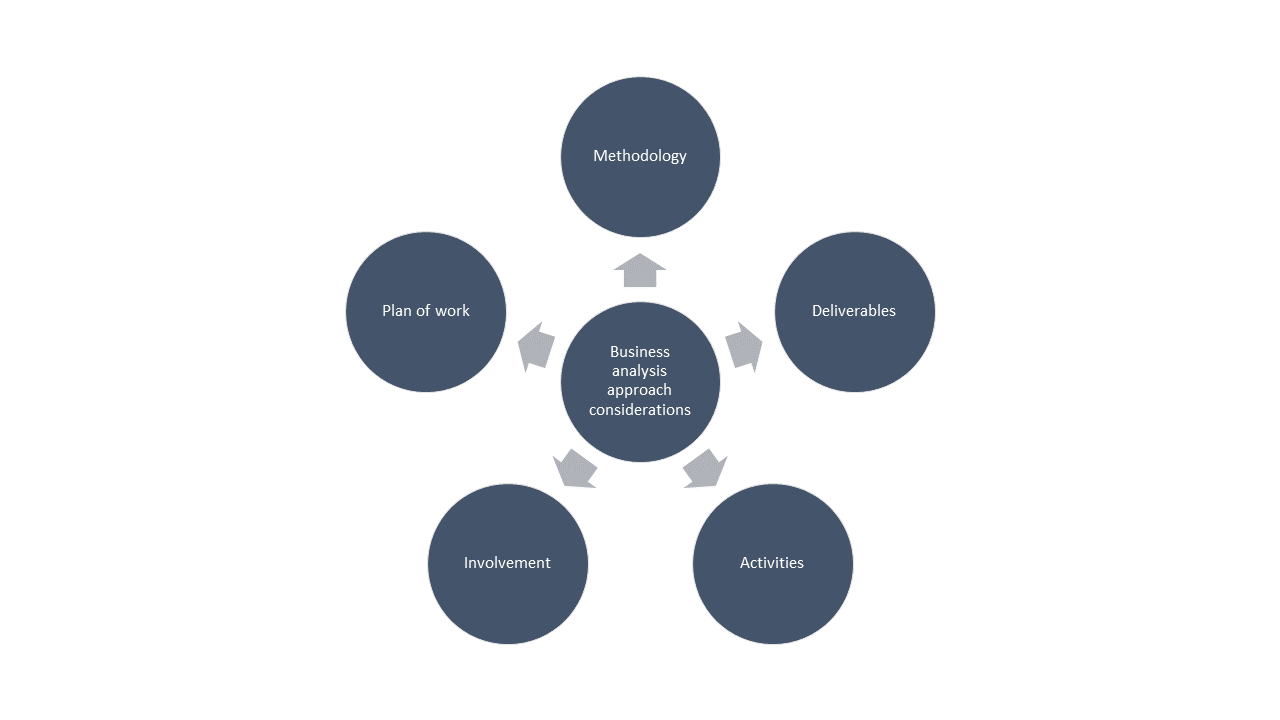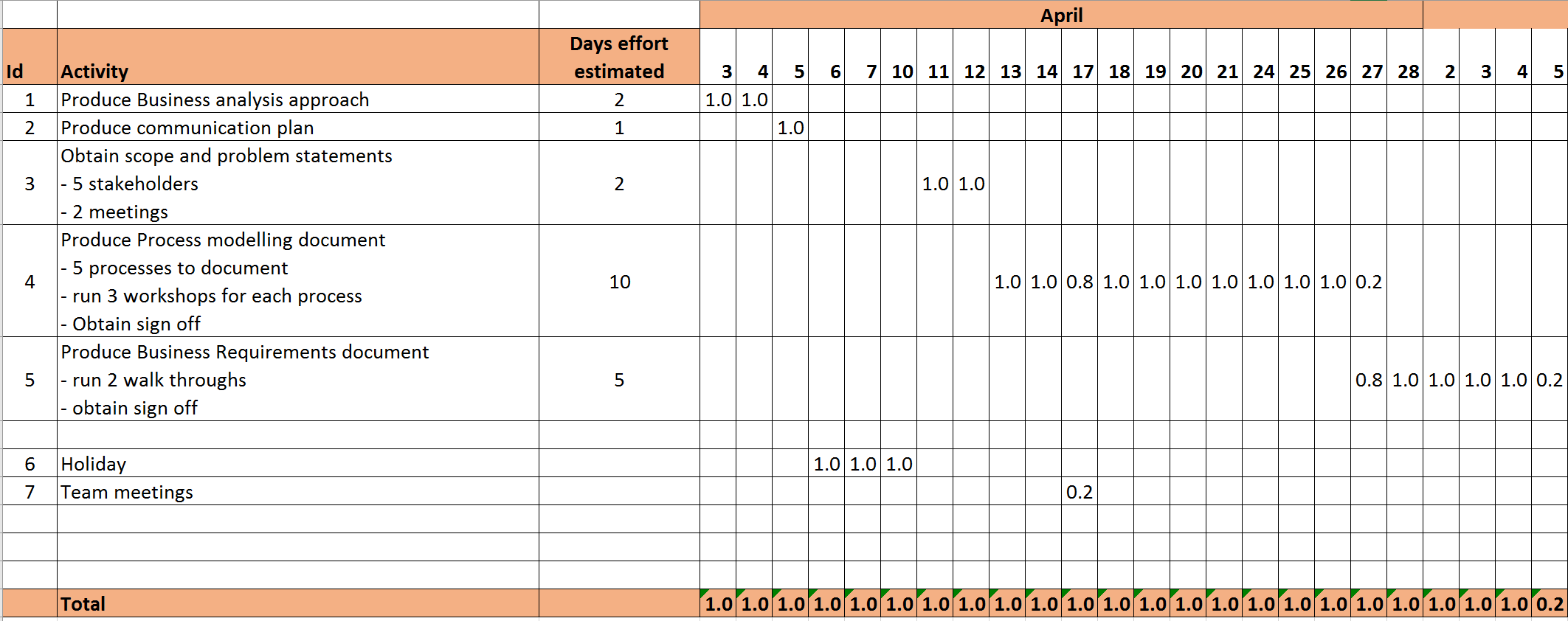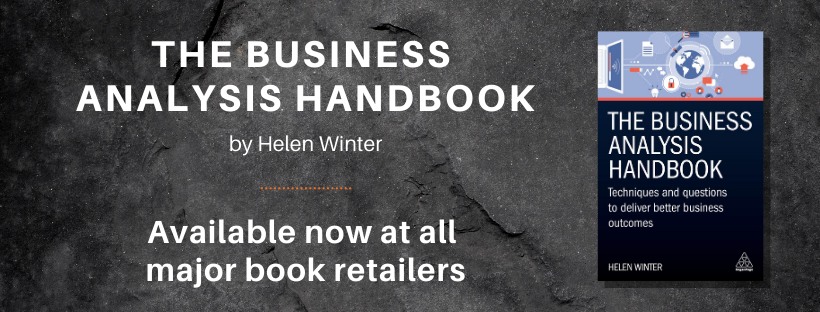
Purpose of Business analysis approach
The purpose of the business analysis approach document is to set out the business analysis involvement for the work concerned to set expectations, to feed into a wider plan and gain agreement on the deliverables.
When to put together a Business Analysis approach document
This could be put together as part of the organisation methodology for the team, a programme of work or by project. Different levels of detail would need to be applied accordingly. It can be used at team level to set out standard artefacts, methodology and approach to enable a common way of working. Other benefits are that it helps establish a training plan for the team and provide benchmarks. At programme level and project level an approach document will enable dependencies such as stakeholder time to be planned in and varying approaches to be adopted depending on the nature of the project.
What to put in a Business Analysis approach document
See diagram below for the considerations. Each one will then be discussed in turn.

Methodology
Organisational/team standards may already set out a repeatable process for conducting business analysis that fits with:
- The corporate culture,
- Delivery and capability approach of the organisation,
- Attitude to risk and;
- Ability to incorporate change.
It is important for a business analyst to understand the organisational/team methodology as it will help them to understand what is expected of them and any constraints they need to work with. If there isn’t one then the business analyst will need to work with the stakeholders to determine the deliverables and approach required ideally in the project planning phase. Variations to methodology at programme / project level depend upon timescales, the size of a project, business need, requirement stability, skills of the team and stakeholder involvement.
The methodology will set out:
- How the work will be delivered. For example; should the work be divided into smaller chunks and delivered in iterations or phases.
- Deliverables including any templates in a standardised format.
- Business analysis techniques. For example; BPMN, UML etc.
- Governance. For example; what stage gates are required and how formal does the process need to be.
Deliverables
Any business analysis involvement should have associated deliverables. As per above these could be specified in the methodology. See A comprehensive guide to the major Business Analyst deliverables for more detail on the types of typical business analysis deliverables and the different naming conventions used. It is also important to identify whether any additional or non-standard artefacts are required which would add value to the project. For example deliverables such as options papers and findings / analysis documents may also need to be incorporated.
Activities
Activities will be required to produce the deliverables. See Business analysis involvement through the project lifecycle for more detail on the types of business analysis activities that are applicable for each part of the project lifecycle.
Involvement
Identify who needs to be involved to be able to produce the deliverables and conduct the activities required. The project manager or sponsor should be able to provide guidance on this. Consideration needs to be given as to:
- How much of their time will be required
- Their availability
- The timelines
- Level of formality required for communication and sign off
Plan of work
Once you have understood the deliverables required, the activities and who needs to be involved it is then possible to identify the dependencies, sequencing and estimation.
Below is an example of a technique for identifying timescales to feed into a plan

This was developed using an excel spreadsheet.
Activities have been put in down the left hand side. The days effort has also been established.
Assuming the meetings were scheduled when required this shows that the business analysis approach document could be complete by the 4th April, the problem statement for the 12 April, the Processes by the 27 April etc.
This is a good way of demonstrating how the days effort estimated can be translated into elapsed time and feed into a plan. It also enables you to plan and add in meeting dates so you can see the impact on the plan if this changes and non-working days.
This will then help to ensure what dates are realistic and enable meetings to be planned. A common technique is then to book placeholder meeting invites with the attendees.
Summary
The business analysis approach sets out the approach for the business analyst work and a description of what is going to be delivered as a result. It can also help to establish buy in if business analyst involvement is new to stakeholders and will also set out how you are going to help them and how they can help you.
Thoughts? Questions? Please share in the comments.
If you have found this article useful then you might like my book – The Business Analysis Handbook – Techniques and Questions for better Business Outcomes. The book is available from www.koganpage.com and all major print and e-book retailers.


I stumbled on your page while researching for Business Analysis deliverables and I must say this is very helpful.
Thanks Ennie, Check out the contents page of this website for an ordered list of all of the articles.
Regards, Helen
Hey, thank you for this information it is very helpful. If I may ask, what are the impact of not following the Business Analysis Approach?
If you don’t have a business analysis approach document there isn’t a clear agreement up front as to who needs to be available, what deliverables are required and what methodology is going to be used. I introduced these documents when helping to mature an existing business analysis team. I found it helps empower the business analyst team into having more of a say in how they intend to do business analysis. Otherwise it can end up being decided for the business analyst by someone who isn’t as familiar with business analysis. It also gives the opportunity for more senior business analysts to have a greater role as they can help set the ground work for the less experienced. So you don’t have to have a business analysis approach document but the quality and maturity of business analysis is more likely to be greater than without one.